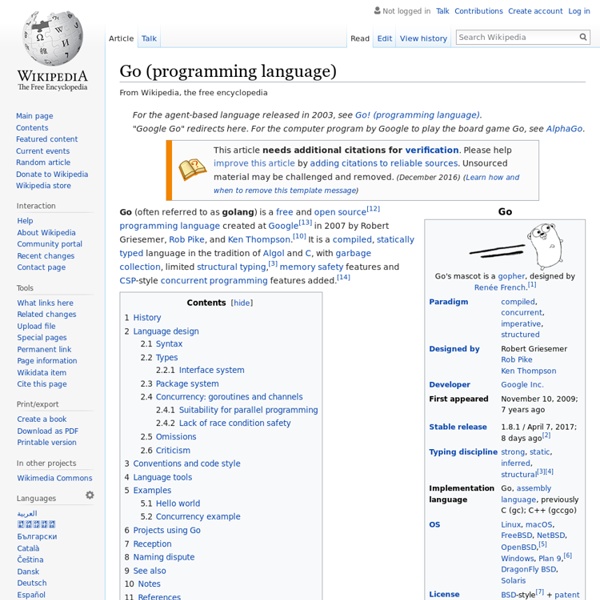



GoForCPPProgrammers - go-wiki - Go for C++ Programmers - Go Language Community Wiki Go is a systems programming language intended to be a general-purpose systems language, like C++. These are some notes on Go for experienced C++ programmers. This document discusses the differences between Go and C++, and says little to nothing about the similarities. An important point to keep in mind is that there are some fundamental differences in the thought processes required to be proficient in the two respective languages. For a more general introduction to Go, see the Go Tour, How to Write Go Code and Effective Go. For a detailed description of the Go language, see the Go spec. Conceptual Differences Go does not have classes with constructors or destructors. Syntax The declaration syntax is reversed compared to C++. Declarations generally take the form of a keyword followed by the name of the object being declared. You can also use a keyword followed by a series of declarations in parentheses. var ( i int m float64) func f(i, j, k int, s, t string) var v = *p This is equivalent to Types
So You Want to Be an App Developer? Here's How [INFOGRAPHIC] Apps are in. There's no denying it. Seems everyone these days has a great idea for a mobile app: apps to find food, apps to find rides, apps to find more apps. The list goes on. But just how do you become an app developer anyway? As with so many paths to success, there's no one rote way. A degree in computer science or software engineering is a very strong foundation. To do that, you'll need a well-rounded skillset, including UI design, familiarity with a range of programming languages, backend computing knowledge and — this one's very important — some savvy business knowledge. The online education portal Schools.com recently surveyed the app landscape, and pulled information from a variety of sources around the web to put together the infographic below, which serves as a primer for aspiring developers.
SyncPad RFC 1149 - Standard for the transmission of IP datagrams on avian carriers [Docs] [txt|pdf] [Errata] Updated by: 2549, 6214 EXPERIMENTAL Errata Exist Network Working Group D. Waitzman Request for Comments: 1149 BBN STC 1 April 1990 Status of this Memo This memo describes an experimental method for the encapsulation of IP datagrams in avian carriers. This specification is primarily useful in Metropolitan Area Networks. This is an experimental, not recommended standard. RFC 1149 IP Datagrams on Avian Carriers 1 April 1990 regenerating. Html markup produced by rfcmarkup 1.109, available from
Putnam model The Putnam model is an empirical software effort estimation model.[1] The original paper by Lawrence H. Putnam published in 1978 is seen as pioneering work in the field of software process modelling. [2] As a group, empirical models work by collecting software project data (for example, effort and size) and fitting a curve to the data. Future effort estimates are made by providing size and calculating the associated effort using the equation which fit the original data (usually with some error). Created by Lawrence Putnam, Sr. the Putnam model describes the time and effort required to finish a software project of specified size. SLIM (Software LIfecycle Management) is the name given by Putnam to the proprietary suite of tools his company QSM, Inc. has developed based on his model. The Software Equation[edit] While R&D projects for the Army and later at GE, Putnam noticed software staffing profiles followed the well-known Rayleigh distribution.[3] where: See also[edit] Software estimation
Software development effort estimation Software development efforts estimation is the process of predicting the most realistic use of effort required to develop or maintain software based on incomplete, uncertain and noisy input. Effort estimates may be used as input to project plans, iteration plans, budgets, investment analyses, pricing processes and bidding rounds. State-of-practice[edit] Published surveys on estimation practice suggest that expert estimation is the dominant strategy when estimating software development effort.[1] Typically, effort estimates are over-optimistic and there is a strong over-confidence in their accuracy. Currently the term “effort estimate” is used to denote as different concepts as most likely use of effort (modal value), the effort that corresponds to a probability of 50% of not exceeding (median), the planned effort, the budgeted effort or the effort used to propose a bid or price to the client. History[edit] Estimation approaches[edit] Selection of estimation approach[edit] See also[edit]
Session Initiation Protocol SIP works in conjunction with several other application layer protocols that identify and carry the session media. Media identification and negotiation is achieved with the Session Description Protocol (SDP). For the transmission of media streams (voice, video) SIP typically employs the Real-time Transport Protocol (RTP) or Secure Real-time Transport Protocol (SRTP). For secure transmissions of SIP messages, the protocol may be encrypted with Transport Layer Security (TLS). History[edit] The protocol was designed with the vision to support new multimedia applications. SIP is distinguished by its proponents for having roots in the Internet community rather than in the telecommunications industry. Protocol operation[edit] SIP employs design elements similar to the HTTP request/response transaction model.[8] Each transaction consists of a client request that invokes a particular method or function on the server and at least one response. Network elements[edit] User agent[edit] Registrar[edit]